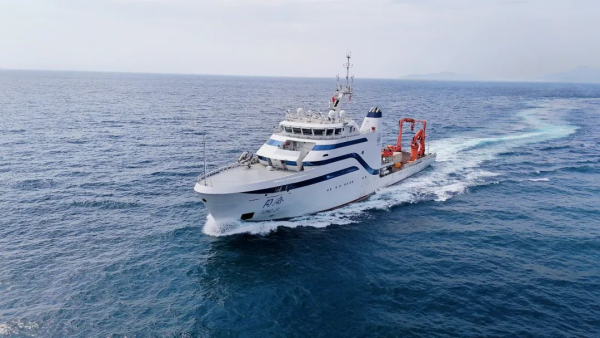China’s first intelligent ocean-class scientific research vessel, called Tongji, was officially delivered in Shanghai on July 13.
The vessel, made to order for the Shanghai-based Tongji University, was independently designed by China Ship Development and Design Center in Wuhan under China State Shipbuilding Corporation Limited (CSSC) and built by CSSC Huangpu Wenchong Shipbuilding Company Limited.

China’s first intelligent ocean-class scientific research vessel, called Tongji, was officially delivered in Shanghai on July 13. [Photo/sasac.gov.cn]
The vessel is a new-generation research ship featuring green, low-noise, and intelligent technologies. It can be used for science research in marine geology, ocean chemistry, and marine biology and will serve primarily as a “floating campus” for Tongji University, supporting both academic research and engineering training at sea.
Measuring 81.5 meters in length, 15 meters in beam, and 6.9 meters in depth, the vessel has a design speed of 15 knots, a cruising range of 8,000 nautical miles, and can accommodate 45 people. It is powered by a fully electric azimuth propulsion system made in China and is capable of world-wide sailing (excluding icy zones). It is also the first domestic research vessel certified by the China Classification Society with all four i-ship intelligent notation symbols (R1, No, E, I), representing its advanced capabilities in shore-based remote control, autonomous navigation in open waters, smart energy management, and integrated intelligent systems.
The ship adopts a hybrid power system combining a direct current bus with lithium iron phosphate battery packs. Its smart energy efficiency system includes intelligent sailing planning, which enhances navigation efficiency while reducing fuel consumption and operating costs.
With strong operational capability, Tongji can carry remotely operated underwater vehicles, multiple containerized onboard laboratories, and various unmanned systems. It also supports integrated networking for mobile and fixed observation nodes.
The vessel is suitable for comprehensive marine scientific research covering marine geology, geophysics, physical oceanography, and ocean chemistry. It is capable of conducting seabed mapping, sediment and structural analysis, ecological studies, as well as research equipment testing. In addition, it can carry out fault detection, maintenance, cable burial, subsea route surveys, sonar scanning, and offshore wind power exploration.
The vessel stands out in the field of intelligent navigation. When sailing in open waters, it can switch to autonomous mode, using advanced sensors to perceive its surroundings and process environmental data to make navigation decisions. Consequently, it can independently avoid obstacles and operate under autopilot, reducing crew workload and minimizing the risk of human error.
Built on a 2,000-metric-ton platform, the vessel maximizes space efficiency, providing 460 square meters of deck workspace, 320 square meters of laboratory area, an average of 10.2 square meters of living space per crew member, and more than 100 square meters for meetings, leisure, and fitness.
(Executive editor: Yuan Ting)